Discover Florida Nature
It's time to explore the natural Florida


|
|
|
|
|
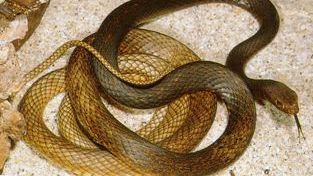 Eastern
Coachwhip Snake- The Eastern Coachwhip is one of the largest
snakes in North America, averaging between 50-72 inches as an adult.
Coachwhips are long and slender, and typically have a black head and
neck, which gradually fades to tan posteriorly. The belly color matches
that of the back. Some eastern coachwhips may be uniformly tan or cream
colored, lacking the dark pigmentation on the head. This snake's head is
large and angular, with large eyes shielded by projecting scales. The
Eastern Coachwhip Snake is found throughout Florida, excluding the
keys. Outside of Florida, it is found from Texas, Oklahoma, and Kansas,
east to North Carolina. Coachwhips are active during the day, are
extremely fast on the ground, and are great climbers. Its diet consists
of lizards, small mammals, and birds. Eastern
Coachwhip Snake- The Eastern Coachwhip is one of the largest
snakes in North America, averaging between 50-72 inches as an adult.
Coachwhips are long and slender, and typically have a black head and
neck, which gradually fades to tan posteriorly. The belly color matches
that of the back. Some eastern coachwhips may be uniformly tan or cream
colored, lacking the dark pigmentation on the head. This snake's head is
large and angular, with large eyes shielded by projecting scales. The
Eastern Coachwhip Snake is found throughout Florida, excluding the
keys. Outside of Florida, it is found from Texas, Oklahoma, and Kansas,
east to North Carolina. Coachwhips are active during the day, are
extremely fast on the ground, and are great climbers. Its diet consists
of lizards, small mammals, and birds. 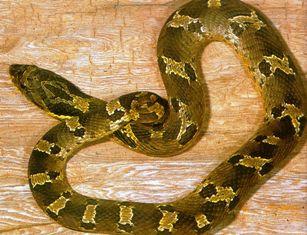 Eastern
Hognose Snake- Adult Eastern Hognose Snakes are usually about
30 inches in length. These snakes have patterns of varying colors,
including blacks, grays, browns, yellows, and oranges. There is also a
black phase. In black phased specimens, the pattern can be seen in grays
in the juveniles, but soon turns to plain black. Black phase specimens
have apparently become more common in recent decades. This snake is one
of the world's most interesting species and best animal actors. When
confronted, the eastern hognose's first defense is an aggressive display
in which it spreads its neck horizontally, inflates its body, hisses
loudly, and strikes. The Hognose principally eat toads. It hunts them in
the toads' burrows during the day, using its upturned nose to root them
out. Eastern
Hognose Snake- Adult Eastern Hognose Snakes are usually about
30 inches in length. These snakes have patterns of varying colors,
including blacks, grays, browns, yellows, and oranges. There is also a
black phase. In black phased specimens, the pattern can be seen in grays
in the juveniles, but soon turns to plain black. Black phase specimens
have apparently become more common in recent decades. This snake is one
of the world's most interesting species and best animal actors. When
confronted, the eastern hognose's first defense is an aggressive display
in which it spreads its neck horizontally, inflates its body, hisses
loudly, and strikes. The Hognose principally eat toads. It hunts them in
the toads' burrows during the day, using its upturned nose to root them
out. 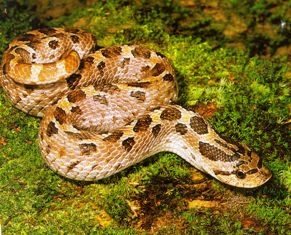 Southern
Hognose Snake- Southern hognose snakes are fairly small,
heavy-bodied snakes that reach about 24 inches in length. These snakes
are easily distinguished from most snakes in our region by their
pointed, upturned snouts. Unlike eastern hognose snakes, which occur in
several color patterns, southern hognose snakes are always gray, tan, or
reddish in color with a series of dark brown blotches down the center of
the back and alternating smaller blotches along the sides. Southern
Hognose snakes were historically found in the Coastal Plain of the
eastern United States from southern North Carolina to southern
Mississippi and in most parts of Florida. Hognose snakes feed almost
exclusively on toads, although they will
occasionally consume other prey. They seem to be immune to poisons
produced by toads, and are equipped with enlarged teeth (called rear
fangs) in the back of their mouths that are used to puncture inflated
toads so that they may be more easily swallowed. Southern
Hognose Snake- Southern hognose snakes are fairly small,
heavy-bodied snakes that reach about 24 inches in length. These snakes
are easily distinguished from most snakes in our region by their
pointed, upturned snouts. Unlike eastern hognose snakes, which occur in
several color patterns, southern hognose snakes are always gray, tan, or
reddish in color with a series of dark brown blotches down the center of
the back and alternating smaller blotches along the sides. Southern
Hognose snakes were historically found in the Coastal Plain of the
eastern United States from southern North Carolina to southern
Mississippi and in most parts of Florida. Hognose snakes feed almost
exclusively on toads, although they will
occasionally consume other prey. They seem to be immune to poisons
produced by toads, and are equipped with enlarged teeth (called rear
fangs) in the back of their mouths that are used to puncture inflated
toads so that they may be more easily swallowed.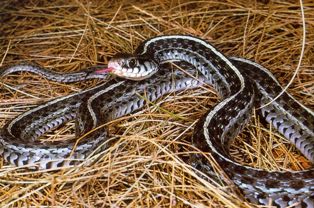 Bluestripe
Garter Snake- The Bluestripe Garter Snake occurs along the
Florida Gulf coast from eastern Wakulla Co. in the panhandle south to
Hernando Co. in the central peninsula. It is not found outside of
Florida. This adult snake averages between 20- 26 inches, with the state
record being 39.25 inches. Bluestripe garters are olive brown to a
blue-black color and have a light blue mid-dorsal stripe. The
bluestripe garter snake is terrestrial and active during the day. It is
frequently found along the banks of canals and ditches, and around
houses in residential areas. After heavy rains, it is sometimes found at
night crossing roads in search of food. It feeds on earthworms, small
fishes, frogs, and
salamanders. Bluestripe garter snakes bear
live young. Bluestripe
Garter Snake- The Bluestripe Garter Snake occurs along the
Florida Gulf coast from eastern Wakulla Co. in the panhandle south to
Hernando Co. in the central peninsula. It is not found outside of
Florida. This adult snake averages between 20- 26 inches, with the state
record being 39.25 inches. Bluestripe garters are olive brown to a
blue-black color and have a light blue mid-dorsal stripe. The
bluestripe garter snake is terrestrial and active during the day. It is
frequently found along the banks of canals and ditches, and around
houses in residential areas. After heavy rains, it is sometimes found at
night crossing roads in search of food. It feeds on earthworms, small
fishes, frogs, and
salamanders. Bluestripe garter snakes bear
live young.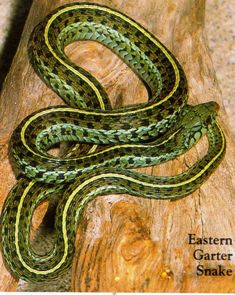 Eastern
Garter Snake- The Eastern Garter Snake is one of our most
common snakes. It grows up to four feet long. It's color patterns can
vary, but it almost always has three yellow stripes. Usually there is a
checkerboard pattern of dark spots between the stripes. Garter snakes
have many types of prey, including: frogs, toads, salamanders,
earthworms, small fish, tadpoles, mice, bird eggs, slugs, crayfish,
leeches, insects, and small snakes. These snakes are usually found near
water or moist places, including marshes, streams, damp woods, wet
meadows, parks, gardens, weed patches, farms, and forest edges. Garter
snakes are good swimmers, but are not as good at climbing as some other
snakes. They spend most of their time on the ground or in low shrubs and
other plants. If attacked, a garter snake will release a bad-smelling
odor. They also bite. Eastern
Garter Snake- The Eastern Garter Snake is one of our most
common snakes. It grows up to four feet long. It's color patterns can
vary, but it almost always has three yellow stripes. Usually there is a
checkerboard pattern of dark spots between the stripes. Garter snakes
have many types of prey, including: frogs, toads, salamanders,
earthworms, small fish, tadpoles, mice, bird eggs, slugs, crayfish,
leeches, insects, and small snakes. These snakes are usually found near
water or moist places, including marshes, streams, damp woods, wet
meadows, parks, gardens, weed patches, farms, and forest edges. Garter
snakes are good swimmers, but are not as good at climbing as some other
snakes. They spend most of their time on the ground or in low shrubs and
other plants. If attacked, a garter snake will release a bad-smelling
odor. They also bite.
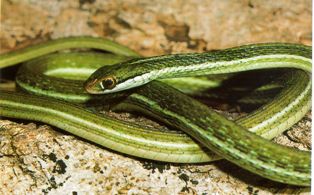 Ribbon
Snake- The Eastern Ribbon Snake is a very thin-bodied snake 18
to 34 inches in length. Similar to the garter snakes, this snake has
three light colored stripes on a dark brown or black background. Each
side strip is bordered below by a brown stripe. Unlike all garter
snakes, the labial scales around the mouth of the ribbon snake are
unmarked and uniformly bright yellow or white in color. The eyes of the
ribbon snake are bordered in the front by a white or light-yellow bar.
Ribbon snakes can be found along the edges of streams, lakes, ponds, and
marshes. Their diet consists primarily of
frogs and
salamanders, which they actively stalk
and pursue. Ribbon
Snake- The Eastern Ribbon Snake is a very thin-bodied snake 18
to 34 inches in length. Similar to the garter snakes, this snake has
three light colored stripes on a dark brown or black background. Each
side strip is bordered below by a brown stripe. Unlike all garter
snakes, the labial scales around the mouth of the ribbon snake are
unmarked and uniformly bright yellow or white in color. The eyes of the
ribbon snake are bordered in the front by a white or light-yellow bar.
Ribbon snakes can be found along the edges of streams, lakes, ponds, and
marshes. Their diet consists primarily of
frogs and
salamanders, which they actively stalk
and pursue.
|
|
|
Advertise | Privacy Statement | Dog Encyclopedia | Video |Contact | Alaska Nature |
|